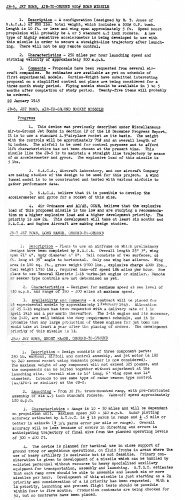1C (3)
JB-9 JET BOMB, SHORT RANGE, GROUND-TO-GROUND
1.
Description - Design consists of three component parts: 250 lb. warhead, airfoil and control assembly, and jet motor (a 180 to 240 second rocket using Monsanto powder is now considered). The maximum weight of any component will not exceed 325 pounds, and the components can be bolted together without adjustment at the launching site. Overall size is 10’ long, 6’ wing span and 14" diameter. Intends to use same type of radar beacon type control (AN/APW-1 or similar) as the JB-2.
2.
Launching - From 30 ft. truck-mounted ramp, with pre-fabricated assembly of six 4.5 inch standard rockets. Take-off speed approximately 180 m.p.h.
3.
Characteristics - Range is 10 - 50 miles and will be dependent on propulsion unit. Maximum speed 300 - 340 m.p.h. Radar plotting accuracy estimated by A.T.S.C. is ±15 yards in range and ±0.5 mils or better in azimuth (±3/4 yards error per mile or range). Overall accuracy will be less because of errors in directing and errors in anticipating trajectory of final dive from the planned operating levels of 300 - 400 ft.
4. The device is planned for tactical use in close support of ground troop or amphibious operations, on fluid fronts in areas where the use of heavy artillery is desirable but is not feasible. Primary consideration is given to development of a missile which can be handled by enlisted personnel without recourse to heavy specialized auxiliary equipment for transportation, assembly and launching. A.T.S.C. estimates that each ramp crew should be able to assemble and launch six or more missiles per hour. Development of this missile is just starting on a 2A priority and consideration of a 1A priority has been requested. With a 1A priority, launching and pre-set flight tests should be possible within four to five months. Production contracts are being checked for 50, but no contracts have been placed.
C5-638O, AF
1C (3)
28 January 1945

